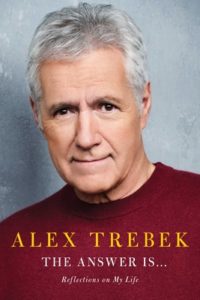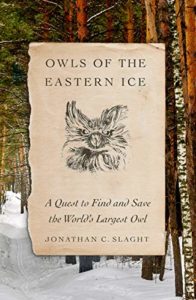
Our five alarm fire of fabulous reviews this week includes Parul Sehgal on Alex Trebek’s The Answer Is…, Masha Gessen on Lawrence Douglas’ Will He Go?, Geraldine Brooks on Maggie O’Farrell’s Hamnet, David L. Ulin on Adrian Tomine’s The Loneliness of the Long-Distance Cartoonist, and Helen Macdonald on Jonathan C. Slaght’s Owls of the Eastern Ice.
*

“It’s little wonder that Trebek has written a memoir of consummate caginess, one of the wariest I’ve read: a friendly, often funny account marked by a reluctance so deep that it confers a curious integrity upon the celebrity tell-all. For years, he resisted personal questions (‘Get a life,’ he’d say in interviews) and resisted writing an autobiography. Only after the outpouring of support following his announcement last year that he had pancreatic cancer did he feel he owed something to the public … Even if he can’t quite understand the public fascination with his life, he knows he means something significant to the culture, something soothing and in short supply. He knows he fills a need. For the 36 years hosting Jeopardy!—an industry record—he has been a nostalgic father figure of sorts, showing up reliably at dinnertime and remaining tantalizingly aloof. In the autumn of the media patriarchs, he stands practically alone, untinged by scandal. His authority derives from his defense of facts, not their distortion … Alex Trebek loves the troops, he loves his wife, he loves his Dodge Ram. He really loves his bromides. His kids? Champs. His divorce? Amazing; he and his ex are still good friends. Around the margins, a darker story blooms … Trebek might have inspired dread in his teachers and early employers, but he discovered that his real talent was in projecting calm, in allowing others to shine.”
–Parul Sehgal on Alex Trebek’s The Answer Is…: Reflections on My Life (The New York Times)

“Lawrence Douglas, a legal scholar and a professor at Amherst College, gave himself the task of methodically thinking through the unthinkable … By the standards of entrenched autocracies, Trump’s grip on power is as weak as his grip on reality. Still, the system of government that he has hijacked is not designed to protect itself against his kind of attack. ‘Our Constitution does not secure the peaceful transition of power, but rather presupposes it,’ Douglas writes. Worse, the peculiar institution of the Electoral College, which separates the outcome of the election from the popular vote, practically invites abuse … Douglas conjures three detailed scenarios, which he calls Catastrophe No. 1, Catastrophe No. 2, and Catastrophe No. 3 … The mortifying beauty of Douglas’s scenarios is that each is based on historical precedent … If he goes—which will require an overwhelming electoral defeat—Trump is not only sure to play the victim, blaming the Deep State and undocumented immigrants for his loss, but also likely to linger and delay his departure. The ragged end of his Presidency, if it comes, will be full of conflict and resentment. There will be no orderly handover, no constructive transition—a disastrous prospect during a pandemic and a deep recession, and yet another blow to our perceptions of how elections and government operate.”
–Masha Gessen on Lawrence Douglas’ Will He Go? Trump and the Looming Election Meltdown in 2020 (The New Yorker)
“As William Styron once wrote, the historical novelist works best when fed on short rations. The rations at Maggie O’Farrell’s disposal are scant but tasty, just the kind of morsels to nourish an empathetic imagination … This novel is at once about the transfiguration of life into art—it is O’Farrell’s extended speculation on how Hamnet’s death might have fueled the creation of one of his father’s greatest plays—and at the same time, it is a master class in how she, herself, does it … O’Farrell, Irish-born, schooled in Scotland and Wales, and shaped by a childhood steeped in story and school days that always began with song, has a melodic relationship to language. There is a poetic cadence to her writing and a lushness in her descriptions of the natural world…She is deft, too, at keeping her research subordinated to the story. We’re not force-marched through a manual on 16th-century glove-making techniques or an exegesis of illegal practices in the Tudor wool trade. But we can smell the tang of the various new leathers in the glover’s workshop, the fragrance of the apples racked a finger-width apart in the winter storage shed … The book builds toward an intriguing speculation, which I will not reveal here. As it unfolds, it brings its story to a tender and ultimately hopeful conclusion: that even the greatest grief, the most damaged marriage and most shattered heart might find some solace, some healing.”
–Geraldine Brooks on Maggie O’Farrell’s Hamnet (The New York Times Book Review)
“… the material here brings us directly in touch with the cartoonist’s obsessive point of view … his self-analysis can make us squirm … It’s a subjectivity similar to that of, say, Ben Lerner or Karl Ove Knausgaard, in which the artist both is and is not the character … It’s a complex weave, made more pronounced by the artifice of the form. Tomine makes this explicit throughout the book … It’s tempting to critique Tomine’s perspective as a little close, a little small, especially at a moment beset by crises. Who has time for self-doubt when the world is coming to an end? But I want to make a counterargument. What better time to look in the mirror than when every one of us is at risk? … the faith of memoir, or autofiction, is that this is what connects us: the expression of our humanity. For Tomine, that means showing us his process; the book ends as he sits down to write it, in a graphpaper sketchbook the design of the book you’re holding re-creates. It’s a full-circle move in the broadest sense, and it leaves us in the middle, where Tomine is, looking backward in order to look ahead.”
–David L. Ulin on Adrian Tomine’s The Loneliness of the Long-Distance Cartoonist (The Los Angeles Times)

“Jonathan Slaght has the best author photograph I’ve ever seen. Pale, bearded, dressed in black, he gazes at the camera with forbidding intensity. Behind him are snowy woods and running water. Arms crossed, hands deep in a pair of unwieldy leather gauntlets, he holds against his chest a huge owl. Its feathers are shaggy and wet, and from its mouth protrudes the tail end of a silver fish. There’s something puppet-like about this creature, like a living Jim Henson creation, but it also resembles a beast pulled straight from the pages of a medieval bestiary—which is fitting, because Owls of the Eastern Ice reads like a modern-day grail quest: a tale of one man’s travels through a daunting landscape of snow and ice and radioactive rivers, searching for an animal that seems all ghost. A confession: I’ve never understood why so many people are obsessed with owls. I once cared for a rescued barn owl, and while it was a beautiful creature, possessing a cat-like hauteur and strangely human face, it was about as rewarding to interact with as a porcelain statuette. But I’m happy to report that this book has changed me. I have become an ardent fan of the largest living species of owl, the Blakiston’s fish owl. Huge, elusive and endangered denizens of the deep forests of Japan, China and the Russian far east, these marvelously odd birds wade through icy water to catch fish, sing in low, hooted duets, possess a thick layer of insulating fat, a wingspan that can top six and a half feet, and have been venerated as gods by the Ainu of Hokkaido. They are, in short, superb owls.”
–Helen Macdonald on Jonathan C. Slaght’s Owls of the Eastern Ice: A Quest to Find and Save the World’s Largest Owl (The Guardian)

